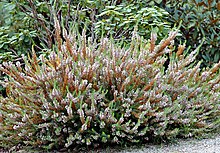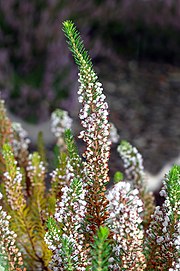Erica vagans
| Erica vagans | |
|---|---|

| |
| Scientific classification | |
| Kingdom: | Plantae |
| Clade: | Tracheophytes |
| Clade: | Angiosperms |
| Clade: | Eudicots |
| Clade: | Asterids |
| Order: | Ericales |
| Family: | Ericaceae |
| Genus: | Erica |
| Species: | E. vagans
|
| Binomial name | |
| Erica vagans | |
Erica vagans,theCornish heathorwandering heath,is aspeciesofflowering plantin thefamilyEricaceae,nativeto Ireland, Cornwall, western France and Spain.[1]It is a vigorous, spreading,evergreenheather reaching 75 cm (30 in) tall and wide, with pink flowers borne inracemes14 cm (6 in) long in summer and autumn. The Latinspecific epithetvagansliterally means "wandering"; in this context it means "widely distributed".[2]
Description
[edit]
Cornish heath is an evergreen subshrub, growing to a height of 1 to 3 ft (30 to 90 cm). The small linear leaves with pale undersides and down-rolled margins grow in whorls of four or five on the wiry stems. The inflorescence is a fat, leafy spike with a few long-stalked, globular flowers; these are pink or lilac and have brown stamens that protrude from the open mouths. The flowering period is from July to September.[3]
Cornish population
[edit]In Great Britain, it is only found onthe Lizard peninsulain southern Cornwall, where theunusual geologygives rise to theacid soilsthat it favours. It was voted theCounty flowerofCornwallin 2002 following a poll by the wild flora conservation charityPlantlife.[4]It is often considered theCornishfloral emblem.[5]
According to one story, this is because whenJoseph of Arimatheafirst arrived in Cornwall looking for tin he had nowhere to stay, so he spent his first night on a bed of Cornish heather. In thankfulness, he blessed the plant and it has been a blessed plant ever since.[6]

Cultivation
[edit]
Like almost all plants in the heath family (Ericaceae),E. vagansrequires an acidic or, at the very least, neutral soil to thrive. In areas with alkaline (basic) soil, this can be achieved by plantingE. vagansin containers with ericaceous compost. Numerouscultivarshave been developed with a range of flower colours in white, pink, mauve and purple.
AGM cultivars
[edit]The following cultivars have gained theRoyal Horticultural Society'sAward of Garden Merit:-[8]
- E. vagans‘Mrs D.F. Maxwell’[9]
- E. vagansf.alba'Cornish Cream'[10](white-flowered variety)
- E. vagansf.alba'Kevernensis Alba'[11](white-flowered variety)
- E. vagansf.alba'Lyonnesse'[12]
- E. vagansf.aureifolia'Valerie Proudley'[13](gold-leaved variety)
References
[edit]- ^RHS A-Z encyclopedia of garden plants.United Kingdom: Dorling Kindersley. 2008. p. 1136.ISBN1405332964.
- ^Harrison, Lorraine (2012).RHS Latin for gardeners.United Kingdom: Mitchell Beazley. p. 224.ISBN9781845337315.
- ^McClintock, David; Fitter, R.S.R. (1961).The Pocket Guide to Wild Flowers.London: Collins. p. 122.
- ^Plantlife websiteCounty Flowers pageArchived2015-04-30 at theWayback Machine
- ^James Minahan,The complete guide to national symbols and emblems,Volume 1, 2009
- ^Nicholls, Steve (2019).Flowers of the Field: Meadow, Moor and Woodland.Head of Zeus. p. 568.ISBN978-1-78954-068-0.
- ^"Croft Pascoe Forest, Cornwall - area information, map, walks and more".Ordnance Survey Get Outside.
- ^"AGM Plants - Ornamental"(PDF).Royal Horticultural Society. July 2017. p. 36.Retrieved6 February2018.
- ^"RHS Plantfinder -Erica vagans'Mrs D.F. Maxwell'".Retrieved17 February2018.
- ^"RHS Plant Selector -Erica vagansf.alba'Cornish Cream'".RHS.Retrieved24 March2020.
- ^"RHS Plant Selector -Erica vagansf.alba'Kevernensis Alba'".Retrieved24 March2020.
- ^"*E. vagansf.alba'Lyonnesse'".RHS.Retrieved19 March2020.
- ^"RHS Plant Selector -Erica vagansf. aureifolia 'Valerie Proudley'".Retrieved23 February2020.

